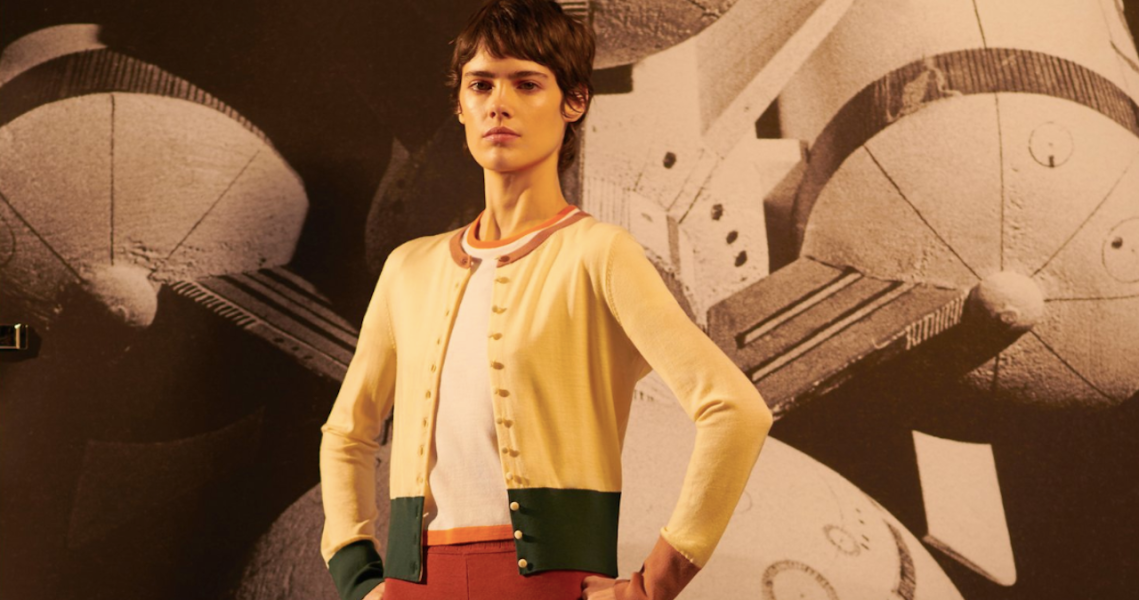In the campaign for the latest collection by Hong Kong–based knitwear brand Ply-Knits, there’s imagery of retro technology and archival photos from the set of “2001: A Space Odyssey.” Notably absent is any indication of the brand’s sustainable practices.
The collection, launched earlier this summer by Ply-Knits and sold direct and at retailers in the China and U.S., including Five Story New York, was created like all of Ply-Knits products — through the use of deadstock.
Designer Carolyn Yim said sustainability is an important part of how the brand operates, but it’s not a central focus of its marketing. At a time when fashion companies are making grand, sweeping promises to be sustainable in the future, like Zara with its recent pledge to use entirely sustainable materials by 2025, it’s rare that a brand does not try to make a big show of its sustainable practices. What’s more, Yim said, a product’s aesthetics can be as important to its impact on the environment as the way it’s made.
Yim spoke with Glossy about sustainability, design and the challenges of running an international business with only 10 employees.
Tell me a bit about the brand.
I started the brand about five years ago. I was working as a buyer at Saks, and I felt like there was just so much stock and waste. That was in 2014, a little after the 2008 recession, and I was having this visceral reaction to there being too much stuff. I wanted to do something about it. My family was in manufacturing, so I saw that a lot. There would be piles and piles of sweaters that were rejected by a client.
There’s all this deadstock that is left over, so we un-spin rejected sweaters and turn them into something new. Now, that idea is popular, but in 2014, it was new. I was really inspired by the food movement back then, like a sushi restaurant that would use all the other fish that the fishermen would otherwise throw away because they weren’t tuna.
It seems like there are two philosophies of sustainability: “We need to make more stuff but do it sustainably” and “We need to stop making new stuff when we already have so much.” You subscribe to the latter?
The most sustainable thing is definitely for clothing to not constantly be producing all this stuff that doesn’t get used. But there’s a benefit to using existing materials. In deadstock, you’re limited to the colors that you have on hand. It can be challenging but really rewarding to work within those boundaries. The trade of yarns has a seasonality to it. The yarn stays the same, but colors go out of date based on the season. Out-of-date yarns should not expire and be thrown away. They’re still usable. The ones that are seasonal colors become deadstock if they are not sold.
Do the majority of your customers come to you because of your sustainability efforts? Or do they come just because they like your sweaters, and the sustainable angle is just the cherry on top?
I believe it’s style first. And I try to design that way, too. If the design is not good, that’s not sustainable, either. Sustainability should be judged by longevity. If you really like something, you will wear it for a long time. Industrial designer Dieter Rams put it like this: Sustainability should come from design, from daily wear and care, and from how products are disposed of. Yes, we use deadstock in production and in knitting a fully fashioned sweater, rather than cutting a shape out of the fabric, but design is something we don’t really talk about. It’s not sustainable if something is so trendy and of-the-moment that it will look outdated in a year. Designing something to last and be sustainable is aesthetic [in addition to technical].
Think of the things that are in your house, like a really excellent chair or lamp. They are classic pieces of design and they are proportionate to standards of beauty and all that, but they are sustainable by virtue of the fact you will keep them around for a long time. I saw someone the other day wearing Balenciaga Triple S sneakers, and it’s amazing how out of date those look already.
How big is the brand? For a smaller brand operating internationally, what has been the biggest challenge for you?
In Hong Kong, it’s a team of 10, but only one person works with me directly. My parents are both involved. It’s a joy, the hilarity of working with your parents. But you also really appreciate it because they kind of read your mind.
The first challenge is, when I first started selling, I was selling in a big multi-brand store in Shanghai. But it was hard to understand the culture and the market. Even though I am Chinese, I’m not Chinese enough. To be such a small business, I’m unable to be there all the time — a bigger business could have a full team in Shanghai and one in New York. In terms of product, because clothing is about identity, I had to adjust Ply-Knits for the Chinese market, which is not what some of the big brands do it. Gucci just slapped a Chinese word on a shirt for the market and a pig for Chinese New Year. It’s a big missed opportunity for a lot of brands if they don’t take the time to understand the market.




